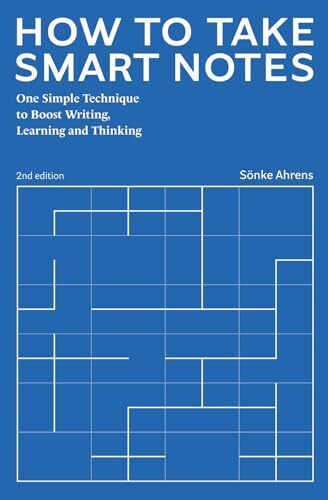
Another book that probably should’ve been a blog post. There is something valuable at the core of this book, which is popularizing a note-taking system originally created by Niklas Luhmann called the “slip box” (AKA “Zettelkasten”). There’s a lot of other philosophizing in the book, but most if it felt like filler.
There are many tutorials online for how to set up a slip box note-taking system, many of which are more concise and clearer than the explanation in this book, and nowadays, there is software designed specifically to implement this system without boxes and note cards, and with better search and linking (e.g., Obsidian, Roam Research, Zettlr, ZKN3).
Most of what this book helps with is understanding why a slip box system might be a more effective way to take notes:
Links between ideas rather than categories of ideas
One key idea is that in a slip box, rather than organizing notes into one high-level topic each (as if filing them in folders), you try to link related notes together from potentially across the entire slip box, so a single note can be potentially linked to many different topics (like hyperlinks between webpages). So instead of starting with a bunch of pre-conceived high-level topics, which are never quite right, you develop ideas bottom-up, linking ideas together, revealing unexpected connections, and allowing the high level topics and concepts to emerge from this process.
A three-part note-taking process
- Take fleeting notes throughout the day. You need a way to jot down thoughts whenever and wherever they happen to pop into your mind throughout the day. Don’t worry about the formatting or keeping things neat or judging your ideas: just jot things down quickly and put them into some sort of “inbox” that you can review at the end of the day.
- Make literature notes while reading. Whenever you are reading, take quick notes on important ideas you wish to remember. You don’t need to jot down entire quotes or tons of details: just capture the central idea, in your own words, as concisely as you can, and then record the bibliographical information so you can find the source later. Add these notes to your “inbox” as well.
- Make permanent notes. At the end of every day, you go through your inbox, and turn the notes there into “permanent notes” by (a) reviewing the fleeting and literature notes you took during the day, (b) expanding these into more complete ideas, discussions, and arguments in your own words, (c) reviewing notes already in your slip box to see how the new notes compare, and (d) creating links and cross-references between the new notes and old notes. Add all these new permanent notes to your slip box and throw the fleeting notes away.
The last step in the process is the single biggest differentiator of the slip box system, as per the next section.
Writing is thinking, connections are understanding
The reason the slip box system works is that merely reading something or thinking it is not enough to understand it. You may believe you understand it, but it is only when you try to externalize it, that you are really forced to grapple with it and see what you actually understand. And one of the absolute most effective ways to externalizing ideas is writing.
The third step in the slip box system, where you create permanent notes, is not a passive process where you’re just storing data, but a highly active process where you develop your ideas, arguments, and discussions. You are actively thinking, on paper, in the form of written notes. You are not just copying quotes from a book, but expressing the ideas in your own words, which is what forces you to truly think. Moreover, you are figuring out how those ideas relate to notes already in your slip box, which entails browsing previous notes, following the links they contain (which will often reveal unexpected insights), reviewing previous ideas, and connecting everything together; this is where real understanding comes from.
In short:
Writing = thinking
Connections = understanding
Any thought of a certain complexity requires writing. Coherent arguments require the language to be fixed, and only if something is written down is it fixed enough to be discussed independently from the author. The brain alone is too eager to make us feel good – even if it is by politely ignoring inconsistencies in our thinking. Only in the written form can an argument be looked at with a certain distance – literally. We need this distance to think about an argument – otherwise the argument itself would occupy the very mental resources we need for scrutinizing it.
As we write notes with an eye towards existing notes, we take more into account than the information that is already available in our internal memory. That is extremely important, because the internal memory retrieves information not in a rational or logical way, but according to psychological rules. The brain also doesn’t store information neurally and objectively. We reinvent and rewrite our memory every time we try to retrieve information.
